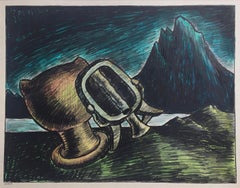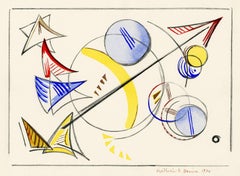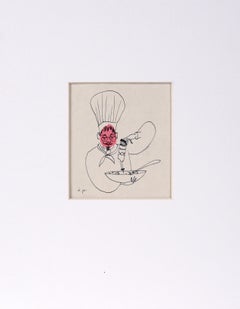Roger Genser - The Prints & The Pauper Mixed Media
to
2
2
Overall Width
to
Overall Height
to
1
1
1
1
1
2
1
1
1
1
2
MASSACHUSETTS BAY COLONY DOCUMENT, 1754 Signed by Wm. Shirley
Located in Santa Monica, CA
MASSACHUSETTS BAY COLONY, (Boston - September 10, 1754)
William Shirley (Captain General and Governor in Chief)
Printed and manuscript Document signed. 13 x 17" Complete with official seal...
Category
1750s Other Art Style Mixed Media
Materials
Ink
$695 Sale Price
26% Off
SURREALIST LANDSCAPE
By Edward Hagedorn
Located in Santa Monica, CA
EDWARD HAGEDORN (AMERICAN 1902 – 1982)
SURREAL LANDSCAPE 1931 mixed media on paper, Graphite, ink and watercolor. Unsigned. Dtaed 2/26/31, in ink lower left margin. Image 13 3/4 x 16 1/2 inches. On a large sheet 20 x 25 inches.
Provenance: Hagedorn estate, Around the mid 1980's The Hagedorn estate was dispersed in Berkeley by a local dealer. This drawing was part of a group of Hagedorn works on paper that I acquired from that dispersal. Much of the balance was later acquired the Struart Denenberg Fine Art.
Denenberg published a very fine book on the artist's work.
EDWARD HAGEDORN: CALIFORNIA MODERNIST, RESTLESSNESS AND RESTRAINT Hardcover – January 1, 2009
Subsequently Hagedorn's works on paper have been acquired by many museums and some accompanying exhibitions.
ALL OF THE COMMENTS BELOW ARE FROM THE FOLLOWING EXHIBITION
EDWARD HAGEDORN (1902-1982)
American Modernist
A New Traveling Exhibition
“VOLCANOS, WRECKS, RIOTS, & NUDES”, EDWARD HAGEDORN (1902-1982)
premiere at the Danforth Museum. Framingham, MA, in March 2016. The exhibition includes 75 works of art in various mediums and is accompanied by the first monograph devoted to the artist’s work with essays by leading curators, critics, and art historians.
Edward Hagedorn was a true Modernist who created a trove of powerful works on paper--drawings, watercolors, oils, and original graphics that reveal the hand of a master draftsman and the mind of an astute political observer. He rejected the general trend in early 20th century California of local landscapes and coastal views, becoming virtually the single voice of Expressionism. He conveyed the darkness and upheaval that gripped the country in the depression years between the two World Wars, 1925- 1935, more forcefully than any of his contemporaries, influenced by German art of the time, engaging in modernist styles of Expressionism and Surrealism.
Hagedorn’s skeletons are ferocious yet somehow endearing; printed in deep black ink on off-white paper, they march across Lilliputian landscapes of grim disorder and destruction. Comets and volcanoes explode in fauvist colors, their other-worldly fluorescent temperas framed in black, while nude female figures, executed in exquisitely refined pen and ink, or graphite line drawings, are as economical in their means as Matisse, and can be compared with the neo-classical drawings of Picasso. Among his most lyrical works of the 1920s is a series of rhythmically abstracted watercolor and ink views of Golden Gate Park, evoking the sensual demi-geometries of Balthus, Derain , and early Mondrian.
American Modernist Edward Hagedorn (1902-1982) was born in San Francisco of German descent; his mother (née Kafka) died in childbirth, and he was legally adopted and raised by his grandmother and aunt. After attendance at the San Francisco School of Fine Arts in the early 1920s, by age 22 he had a studio in the famed "100" block of Montgomery Street ("the Monkey Block,") then a haven for bohemians.
In 1926, a year of tremendous importance in California artists' embrace of modern art, the Oakland Art Gallery, with the guidance and inspiration of their European representative Emmy (Galka) Scheyer, was the first museum in the United States to show the art of the "Blue Four," among the leading artists of International Modernism--Paul Klee, Lyonel Feininger, Alexei Jawlensky...
Category
1930s American Modern Mixed Media
Materials
Watercolor
$3,000 Sale Price
33% Off
Related Items
Variation 4, Vol. I
By Katherine Sophie Dreier
Located in Myrtle Beach, SC
Katherine S. Dreier, 'Variation 4, Vol. I' from '1 to 40 Variations', lithograph with pochoir and hand-coloring, 1934, edition 65. Stenciled signature and date, lower right. Annotate...
Category
Mid-20th Century American Modern Abstract Prints
Materials
Watercolor, Lithograph, Stencil
Chef Pasta - Vintage Illustration in Ink and Watercolor
By Irene Pattinson
Located in Soquel, CA
Chef Pasta - Vintage Illustration in Ink and Watercolor
A charming illustration, by Irene Pattinson (American, 1909-1999), shows a chef in an 1800's toque blanche, pouring oil from an ornate bottle over a bowl. His face, with spectacles, a moustache and goatee in fine line work, is painted in vibrant pink watercolor for an added splash of color.
Signed in the bottom right corner, "i.p."
Presented in a new white mat with foam core backing.
Mat size: 8.5"H x 11"W
Paper size: 6.75"H x 6.75"W
Image size: 4.13"H x 3.63"W
Irene Pattinson (American, 1909-1999) studied at the California School of Fine Art (now The San Francisco Art Institute), San Francisco State College and The Marion Hartwell School of Design. She was President of the San Francisco Woman Artists Association 1955-56.
Provenance: The Artist, Estate of Irene Pattinson: David Carlson; Estate of Larry Miller Fine Art, Robert Azensky Fine Art.
Solo Exhibitions: Lucien Labaudt Gallery 1955; San Francisco Museum of Art, 1961 (39 works).
Selected Group Exhibitions: San Francisco Art Association Annual 1948, 54, 55; San Francisco Woman Artists, 1957-1960; Oakland Art Museum Annual, 1951, 58; California Palace of the Legion of Honor, 1960; Richmond Art Center, 1955, 56, 57, 58; San Francisco Art Institute 1959, 60. The Art Bank of the San Francisco Art Association, 1958, 59, 60, 62, 63; Winter Invitational, California Palace of The Legion of Honor, San Francisco, 1960; Fourth Winter Invitational, California Palace of The Legion of Honor, San Francisco, 1963.
Awards: First Place, San Francisco Woman Artists Assoc., 1957, 1959; San Francisco Art Festival 1957;Literature: San Francisco Art Institute - A catalog of the Art Ban 1962/63; San Francisco and the Second Wave: The Blair Collection
Exhibitions:
1963 The Art Bank of the San Francisco Art Association, San Francisco, CA
1963 California Palace of The Legion of Honor: Forth Winter Invitational, San Francisco, CA
1962 The Art Bank of the San Francisco Art Association, San Francisco, CA
1961 San Francisco Museum of Art, San Francisco, CA
1960 California...
Category
1950s American Modern Figurative Drawings and Watercolors
Materials
Paper, India Ink, Watercolor, Pen
$440 Sale Price
20% Off
H 11 in W 8.5 in D 0.25 in
Family at the Beach WPA Modernism American Scene Social Realism Mid 20th Century
By William Gropper
Located in New York, NY
Family at the Beach WPA Modernism American Scene Social Realism Mid 20th Century
William Gropper (1898 - 1977)
"Family at the Beach"
27 1/2 x 19 1/2 inches
Mixed media on paper, c. 1940
Signed lower left
Provenance: Estate of the artist.
The drawing will ship from the home of Mr. Gropper's grandson.
Bio
Throughout his life, William Gropper used his artistic talents to protest social injustice. Born in New York City, he grew up there in poverty and left high school to work as a dishwasher and delivery boy. He eventually began a career in art and was able to study with Robert Henri and George Bellows from 1912 to 1915. He adopted their realistic painting style, and his own work expressed sympathy for common laborers and outrage at society's ills.
In 1919 Gropper established a reputation as a political cartoonist working for the New York Tribune. His blunt, forceful style attracted the attention of other publications, and he provided illustrations and cartoons for a variety of magazines, from the left-wing New Masses to mainstream Vanity Fair. Like many social realist artists of the 1930s, Gropper supported liberal political causes, depicting subjects such as the plight of migrant laborers and striking factory workers.
In his first gallery exhibition in 1936 at ACA Galleries, Gropper's work was so well received by critics, collectors, and artists that the following year he had two one-man exhibitions at ACA Galleries. In 1937, Gropper traveled west on a Guggenheim Fellowship and visited the Dust Bowl and the Hoover and Grand Coulee Dams, sketching studies for a series of paintings and a mural he painted for the Department of the Interior. That same year he had paintings purchased by both the Metropolitan Museum of Art and the Museum of Modern Art.
Gropper exhibited at the 1939 New York World's Fair, Whitney Museum of American Art (1924-55), Art Institute of Chicago (1935-49), Carnegie International (1937-50), Pennsylvania Academy of the Fine Arts (1939-48), and National Academy of Design (1945-48). He was a founder of the Artists Equity Association and member of the National Institute of Arts and Letters.
From 1940 to 1945 William Gropper was preoccupied with anti-Nazi cartoons...
Category
1940s American Modern Figurative Drawings and Watercolors
Materials
Paper, Ink, Watercolor, Gouache
MODERNIST DRAWING New Hope Mid-Century WPA Abstract Non-Objective Jazz Modern
By Ramstonev (Ramsey/Stone/Evans co-operative)
Located in New York, NY
MODERNIST DRAWING New Hope Mid-Century WPA Abstract Non-Objective Jazz Modern. Signed with a "Ramstonev" stamp lower right.
RAMSTONEV Cooperative Art Project (1937-1939). In the late 1930s, Charles Ramsey became close friends with Charles Evans and Louis Stone. He persuaded them to join him teaching his New Hope summer classes in non-objective painting. Soon, a history-making collaboration began. In 1937, meeting in Evans' studio at the rear of Cryer's Hardware store on Main Street in New Hope, a decision was made to establish the Co-Operative Painting Project. They were intrigued by the cooperative ad-lib process by which jazz musicians created their music. Believing this to be the quintessential American contribution to music, they theorized that a similar result might be obtainable with art, a "visual jam session." This particlarly fascinated Ramsey, who was a jazz buff and had a large collection of jazz records.
The objective was to jointly collaborate in the creation of a painting as well as applying collective criticism during its creation. By creating forward movement by general consent, they believed they could produce a higher level of beauty. By consensus it was decided that subject matter would be non-objective. Up to eight people would participate and stop when the painting "felt" finished by common agreement.
These co-operative works were done in several different mediums- the majority in pastel, but some in watercolor, gouache, graphite or cut paper collage. On occasion, the group would create a series, as opposed to a single work, created in steps by three or four artists. One of the occasional participants was famed New Hope poet, Stanley Kunitz. These series could range in number from four to sixteen paintings in each. The first of a series would be very basic and the last a fully finished work.
In the scope of importance among the New Hope Modernist...
Category
1930s American Modern Abstract Drawings and Watercolors
Materials
Paper, Watercolor, Gouache
Yiddish Theatre Cubist Costume Design 1924 Deco Color Field Modernism Broadway
Located in New York, NY
Yiddish Theatre Cubist Costume Design 1924 Deco Color Field Modernism Broadway.
Boris Aronson (1898 – 1980) "Day and Night," 17 ½ x 13 inches. Gouache ...
Category
1920s American Modern Figurative Drawings and Watercolors
Materials
Paper, Watercolor, Gouache
$8,500
H 31 in W 25 in D 2 in
'Variation 5, Vol. I' — from the series '1 to 40 Variations'
By Katherine Sophie Dreier
Located in Myrtle Beach, SC
Katherine S. Dreier, 'Variation 5, Vol. I' from '1 to 40 Variations', lithograph with pochoir and hand-coloring, 1934, edition 65. Stenciled signature and date, lower right. Annotate...
Category
Mid-20th Century American Modern Abstract Prints
Materials
Watercolor, Lithograph, Stencil
$1,800
H 8.5 in W 11.875 in
1964 San Francisco Construction Site Large Gouache and Pastel Landscape
By Gloria Dudfield
Located in Arp, TX
Gloria Dudfield
Tractor at Work
6-10-64
Gouache and Oil Pastel on Paper
36"x32 1/2" Unframed
Signed and dated lower right in crayon
Very Good Condition - Minor wear consistent with ...
Category
1960s American Modern Mixed Media
Materials
Paper, Oil Pastel, Gouache
And His Open Arms Embraced
Located in Clayton, MO
In And His Open Arms Embraced color, line, shape, and texture collide with handwritten romantic fragments of prose on Kozuke ivory paper. This one-of-a-kind, unmounted encaustic mono...
Category
2010s Abstract Abstract Paintings
Materials
Wax Crayon, India Ink, Encaustic, Archival Paper, Rice Paper, Pen, Color...
Fleurus Airship French Army
By Norman Wilkinson
Located in Middletown, NY
A portait of the first Allied airship to perform a bombing raid from the sky by a celebrated artist whose work hung on the Titanic.
Watercolor and ink on heavy wove watercolor paper, 10 5/8 x 15 inches (270 x 380 mm). Signed in black watercolor in the lower right image area. In very good condition with minor surface soiling on the verso. Titled "Verdun" in pencil on the verso in the artist's hand. Adhered on the verso to matboard at the extreme margins with non archival tape. Presented handsomely in a simple, period maple frame. Titled, dated, inscribed and initialed by the artist on a label on the frame back.
Born in Cambridge in 1898 and educated at Southsea School of Art, Norman Wilkinson is known for his graphic art, specifically his British Railway poster images, and also for something quite incredible; Wilkinson revolutionized the art of naval camouflage. Having been assigned to submarine patrols in Dardanelles, Gallipoli, and Gibraltar during WWI as a member of the Royal Navy Volunteer Reserve, Wilkinson was deeply troubled by the unprecedented success the German submarine fleet had torpedoing British ships. He hoped to find a solution to this gaping vulnerability, and in a lightning bolt moment, he had an epiphany that would change everything. Wilkinson says in his autobiography, A Brush With Life (Seeley, 1969), that he realized a ship could be painted to hide its shape against the sea and sky. In his own words, Wilkinson states that the hull of a ship could be camouflaged "not for low visibility, but in such a way as to break up her form and thus confuse a submarine officer as to the course on which she was heading." After some preliminary testing, the theory Wilkinson called "dazzle camouflage" was accepted by British Admiralty and Wilkinson was placed in charge of the naval camouflage unit. The unit, which was headquartered in the basement of the Royal Academy of Arts, consisted of Wilkinson and about two dozen "camoufleurs;" they were artists, students, model makers and consultants, including a zoologist. The dazzle schemes were tested on models and then distributed to artists who were stationed at the docks, where the ships would be painted. At the end of the war Wilkinson was formally declared the inventor of dazzle camouflage and awarded for his contribution.
Wilkinson went on to enjoy a long and celebrated career as a painter of maritime scenes, naval vessels, and warships. He served as the president of the Royal Institute of Painter in Water Colours (RI) from 1936 until 1963 (having been elected a member in 1906); he was elected Honourable Marine Painter to the Royal Yacht Squadron in 1919, and he was a member of the Royal Society of British Artists, the Royal Institute of Oil Painters, the Royal Society of Marine Artists, and the Royal Scottish Society of Painters in Watercolour. In 1918 he was appointed an Officer of the Order of the British Empire (OBE), and a Commander of the Order (CBE) in 1948. In January 1920 he was appointed knight (chevalier) of the Belgian Order of the Crown.
Among the many notable points of interest regarding Wilkinson's career is that his painting Plymouth Harbour, which was commissioned by Cunard White Star Lines for the first class smoking room of the RMS Titanic, was lost at sea when it perished with the ship. Wilkinson had also created a comparable painting entitled The Approach to the New World, which hung in the same location on the Titanic's sister ship, the RMS Olympic...
Category
Early 20th Century Realist Figurative Drawings and Watercolors
Materials
Ink, Watercolor
Second Mesa Hopi Pueblo Arizona Multicolored Southwest Mixed Media Landscape Art
Located in Denver, CO
"Second Mesa (Hopi Pueblo, Arizona)" is a stunning mixed media artwork by Bert Van Bork (1928-2014), created using watercolor, ink, and charcoal on paper...
Category
1980s American Modern Landscape Drawings and Watercolors
Materials
Charcoal, Archival Ink, Watercolor
$3,250
H 27 in W 26 in D 1.5 in
Abstract Mid 20th Century WPA Non Objective American Modernism New Hope Modern
By Louis Stone
Located in New York, NY
Abstract Mid 20th Century WPA Non Objective American Modernism New Hope Modern.mixed media. 21 x 16 (sight). Housed in a hand carved frame.
Louis King Stone ...
Category
1940s American Modern Mixed Media
Materials
Gouache, Board
$33,000
H 29 in W 23 in D 2 in
Hopi Village on First Mesa, Arizona: Red, Blue, Orange Mixed Media Landscape Art
Located in Denver, CO
This striking mixed-media artwork, titled Walpi #9 (Hopi Village on First Mesa, Arizona), is a masterful combination of watercolor, ink, and charcoal on paper by Bert Van Bork...
Category
1990s American Modern Landscape Drawings and Watercolors
Materials
Charcoal, Ink, Watercolor
$1,850
H 14.5 in W 17.5 in D 1 in



